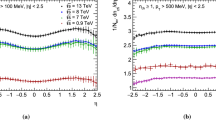Summary
An effective method of analysing the experimental jets with the aim of discovering the clusterization phenomenon of particles produced in high-energy inelastic processes is proposed. The method exploits the set of all possible rapidity intervals,i.e. rapidity differences of two particlesy i+k+1 −y i with somek particles having rapidities in between (the usual gap corresponds tok = 0). It provides information which is in principle as complete as that obtained from the correlation functions. It is simple in application and physically clear. The method is applied to various models and the rapidity interval distributions thus obtained are compared to the experimental data for π−p 40 GeV and pp 70 and 200 GeV collisions. The important role of clusterization of secondary particles follows from this comparison. It is predicted that the two-bump structure should develop fork ≥ 4 and large multiplicities in pp interactions at 200 GeV if two baryonic clusters were produced.
Riassunto
Si propone un metodo efficace per analizzare i fasci sperimentali con lo scopo di scoprire il fenomeno di ammassamento delle particelle prodotte in processi anelastici di alta energia. Il metodo utilizza l’insieme di tutti gli intervalli possibili di rapidità, cioè le differenze di rapidità di due particelley i+k+1 −y i conk particelle aventi rapidità intermedia (il gap solito corrisponde ak = 0). Esso fornisce informazioni che sono in linea di principio complete come quelle ottenute dalle funzioni di correlazione. Esso è semplice nell’applicazione e fisicamente chiaro. Si è applicato il metodo a numerosi modelli e le distribuzioni dell’intervallo di rapidità così ottenute sono state confrontate con i dati sperimentali per le collisioni π−p di 40 GeV e pp di 70 e 200 GeV. L’importante ruolo dell’ammassamento delle particelle secondarie segue da questo confronto. Si predice che la struttura a due rigonfiamenti si svilupperebbe perk≥4 e grandi molteplicità nelle interazioni pp a 200 GeV se due ammassi barionici fossero prodotti.
Реэюме
Предлагается зффективный метод аналиэа зкспериментальных данных, направленный на поиски кластериэации вторичных частиц в процессе множественной генерации при высоких знергиях. В зтом методе испольэуются все воэможные быстротные интервалы, т.е. исследуются распределения поkrn=y i+k+1 −y i; где 0⩽k⩽n − 2, 1⩽i⩽n −k − 1. Обычные распределения по « шелям » соответствуютk = 0. Метод прост в применении и фиэически нагляден. Метод испробован на раэличных моделях и теоретические распределения сравнены с зкспериментом по π−p вэаимодействиям приE = 40 ГзВ и рр приE = 70, 200 ГзВ. Сравнение покаэало важную роль кластериэации вторичных частиц. Если обраэуются два барионных кластера, то предскаэыватся « двугорбовая » структура в распределениях по 5,4 r n при больщих n в рр вэаимодействиях приE = 200 ГзВ.
Similar content being viewed by others
References
M. Miesowicz: inProgress in Elementary Particles and Cosmic Ray Physics, Vol.10, edited byJ. G. Wilson andS. A. Wouthuysen (Amsterdam, 1971), p. 103.
I. M. Dremin andA. M. Dunaevskii:Phys. Rep.,18 C, 159 (1975).
P. Pirilä andS. Pokorski:Lett. Nuovo Cimento,8, 141 (1973).
C. Quigg, P. Pirilä andG. H. Thomas:Phys. Rev. Lett.,34, 290 (1975).
T. Ludlam andR. Slansky:Phys. Rev. D,8, 1408 (1973).
M. I. Adamovich andS. P. Kharlamov:Physics Comments, edited by P. N. Lebedev Inst., No. 12 (1974), p. 3.
M. I. Adamovich, N. A. Dobrotin, V. G. Larionova, M. I. Tretjakova, S. P. Kharlamov andM. M. Chernjavskii:Yad. Fiz.,22, 530 (1975) (English translation:Sov. Journ. Nucl. Phys.,22 (1975)).
The rapidity plateau is predicted by the multiperipheral theory and roughly agrees with experiment (see, for example, (2)).
Yu. V. Prokhorov andYu. A. Rozanov:The Probavility Theory (Moscow, 1973), p. 17.
A. M. Gershkovich andI. M. Dremin:Physics Comments, edited by P. N. Lebedev Institute (1976).
T. Ludlam andR. Slansky:Phys. Rev. D,12, 59, 65 (1975).
E. I. Volkov, I. M. Dremin, A. M. Dunaevskii, I. I. Royzen andD. S. Chernavskii:Yad. Fiz.,17, 407 (1973);18, 437 (1973);20, 149 (1974) (English translation:Sov. Journ. Nucl. Phys.,17, 208 (1973);18, 226 (1973);20, 78 (1974)).
E. I. Volkov, T. I. Kanarek, I. I. Royzen andD. S. Chernavskii: inProceedings of the IV Seminar on High-Energy Physics (Dubna, 1975).
E. I. Volkov andT. I. Kanarek: JINR Communications No. 1-8035 (1974); preprint P. N. Lebedev Institute, No. 115 (1974).
D. S. Chernavskii, T. I. Kanarek andE. I. Volkov: preprint P. N. Lebedev Institute, No. 53 (1975).
M. I. Adamovich, E. I. Volkov, V. G. Larionova, M. I. Tretjakova, S. P. Kharlamov, M. M. Chernjavskii andF. R. Yagudina: preprint P. N. Lebedev Institute, No. 149 (1975).
M. Jacob andR. Slansky:Phys. Rev. D,5, 1847 (1972).
This is necessary to diminish the role of the process with resonances.
Author information
Authors and Affiliations
Additional information
To speed up publication, the authors of this paper have agreed to not receive the proofs for correction.
Rights and permissions
About this article
Cite this article
Adamovich, M.I., Chernjavskii, M.M., Dremin, I.M. et al. Clusters and the rapidity interval method. Nuov Cim A 33, 183–194 (1976). https://doi.org/10.1007/BF02748694
Received:
Published:
Issue Date:
DOI: https://doi.org/10.1007/BF02748694



